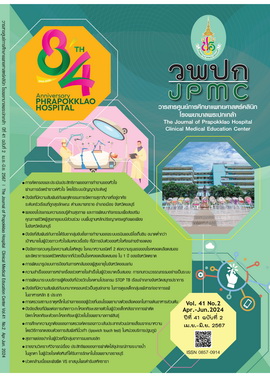Factors Associated Bone Flap Resorption Following Pediatric Autologous Cranioplasty in Kalasin Hospital
Main Article Content
Abstract
BACKGROUND: Children account for roughly 4.1% of TBI-related deaths. The most frequent surgery is a decompressive craniectomy (DC) followed by a cranioplasty (CP), which involves a high rate of surgical complications.
OBJECTIVES: This study aimed to assess the risk factors for bone flap resorption (BFR).
METHODS: A retrospective analysis was conducted at Kalasin Hospital, Thailand, utilizing 22 patients who underwent CP with autologous bone flaps from October 2020 to May 2023. Data were collected utilizing medical records and CT brain scans. Data were analyzed by mean and standard Deviation (SD) or median and Interquartile range (IQR) and compared by Fisher’s exact test and Mann-Whitney U test.
RESULTS: Using an autologous bone flap, 22 patients were enrolled in the trial. The mean age was 15±4 years. The most frequent reason for DC was TBI. The median time between DC and CP was 90 days (80-137). The median bone flap size was 73 cm2 (49-122). Surgical complications were experienced by 3 patients (13.6%), with the most frequent complications being BFR (13.6%), which required repeat surgical intervention, implant dislodgement (4.5%), and hydrocephalus (9.1%); one patient required a VP shunt. It was observed that large bone flaps (p=0.04), bone flap size larger than 115 cm2 (p=0.02), and contusional hemorrhage at first admission (p=0.006) were associated with a higher rate of BFR.
CONCLUSIONS: Because of the patient's financial situation and cosmesis, autologous cranioplasty was primarily performed at our hospital. Therefore, it is important to choose a good patient to avoid BFR. Finally, patients with large bone flaps and contusional hemorrhage should also be monitored closely and persistently to track the BFR.
KEYWORDS: pediatric cranioplasty, autologous cranioplasty, bone flap resorption, complication
Thaiclinicaltrials.org number, TCTR20240609003
Article Details

This work is licensed under a Creative Commons Attribution-NonCommercial-NoDerivatives 4.0 International License.
References
Centers for Disease Control and Prevention. Surveillance report of traumatic brain injury-related deaths by age group, sex,and mechanism of injury-United States, 2018 and 2019 [Internet]. 2022 [cited 2024 Jan 2]. Available from: https://www.cdc.gov/traumaticbraininjury/pdf/tbi-surveillance-report-2018-2019-508.pdf
Alexiou G, Prodromou N, editors. Pediatric neurosurgery for clinicians. Cham: Springer Nature Switzerland AG; 2022.
Thongmeesi S. 2021 Thailand trauma statistics in adult (age 16-60 yr.) [Internet]. 2022 [cited 2024 Jan 2]. Available from: http://49.231.15.21/crhfileload/upload/files/TEAF256504272018203421.pdf
Lui A, Kumar KK, Grant GA. Management of severe traumatic brain injury in pediatric patients. Front Toxicol [Internet] 2022 [cited 2024 Jan 1];4:910972. Available from: https://www.ncbi.nlm.nih.gov/pmc/articles/PMC9263560/pdf/ftox-04-910972.pdf
Honeybul S, Kolias AG, editors. Traumatic brain injury: science, practice, evidence and ethics. Cham: Springer Nature Switzerland AG; 2021.
Derakhshanfar H, Pourbakhtyaran E, Rahimi S, Sayyah S, Soltantooyeh Z, Karbasian F. Clinical guidelines for traumatic brain injuries in children and boys. Eur J Transl Myol [Internet]. 2020 [cited 2024 Jan 1];30(1):8613. Available from: https://www.ncbi.nlm.nih.gov/pmc/articles/PMC7254418/pdf/ejtm-30-1-8613.pdf
Salama AA, Ibbett I, Thani N. Paediatric cranioplasty: a review. Interdisciplinary Neurosurgery 2018;13:59-65.
Brommeland T, Rydning PN, Pripp AH, Helseth E. Cranioplasty complications and risk factors associated with bone flap resorption. Scand J Trauma ResuscEmerg Med [Internet]. 2015 [cited 2024 Jan 1];23:75. Available from: https://www.ncbi.nlm.nih.gov/pmc/articles/PMC4595108/pdf/13049_2015_Article_155.pdf
Hersh DS, Anderson HJ, Woodworth GF, Martin JE, Khan YM. Bone flap resorption in pediatric patients following autologous cranioplasty. Oper Neurosurg (Hagerstown) 2021;20:436-43.
Poolsawat A, Jitpun E. Complications of cranioplasty using autologous bone graft versus syntheticbone tissue following decompressive craniectomy for traumatic brain injury. Buddhachinaraj Med J 2023;37:347-55.
Rocque BG, Amancherla K, Lew SM, Lam S. Outcomes of cranioplasty following decompressive craniectomy in the pediatric population. J Neurosurg Pediatr 2013;12:120-5.
Krejcie RV, Morgan DW. Determining sample size for research activities. Educational and Psychological Measurement 1970;30:607-10.
Bowers CA, Riva-Cambrin J, Hertzler DA 2nd, Walker ML. Risk factors and rates of bone flap resorption in pediatric patients after decompressive craniectomy for traumatic brain injury. J Neurosurg Pediatr 2013;11:526-32.
Rocque BG, Agee BS, Thompson EM, Piedra M, Baird LC, Selden NR, et al. Complications following pediatric cranioplasty after decompressive craniectomy: a multicenter retrospective study. J Neurosurg Pediatr 2018;22:225-32.
Primalani NK, Chew KY, Ramachandran S, Ng LP, Low DCY, Seow WT, et al. Paediatriccranioplasty-experience from a Singapore children’s hospital. Interdisciplinary Neurosurgery [Internet]. 2022 [cited 2024 Jan 1];30:101606. Available from: https://www.sciencedirect.com/science/article/pii/S2214751922001207/pdfft?md5=caef829b900147c7078d292d6a357b28&pid=1-s2.0-S2214751922001207-main.pdf

